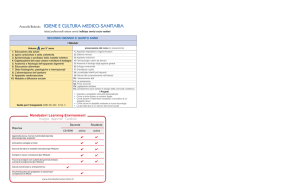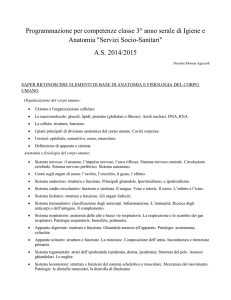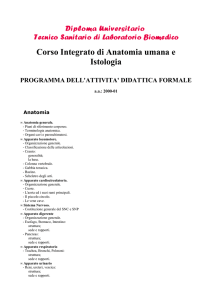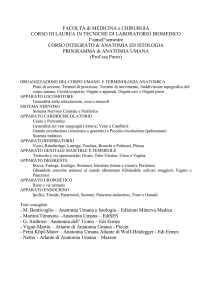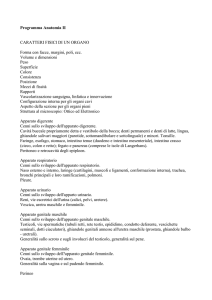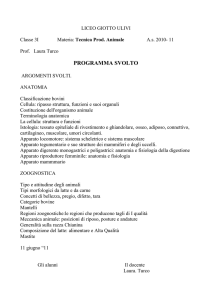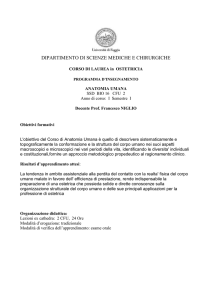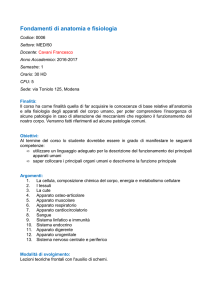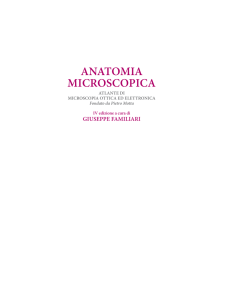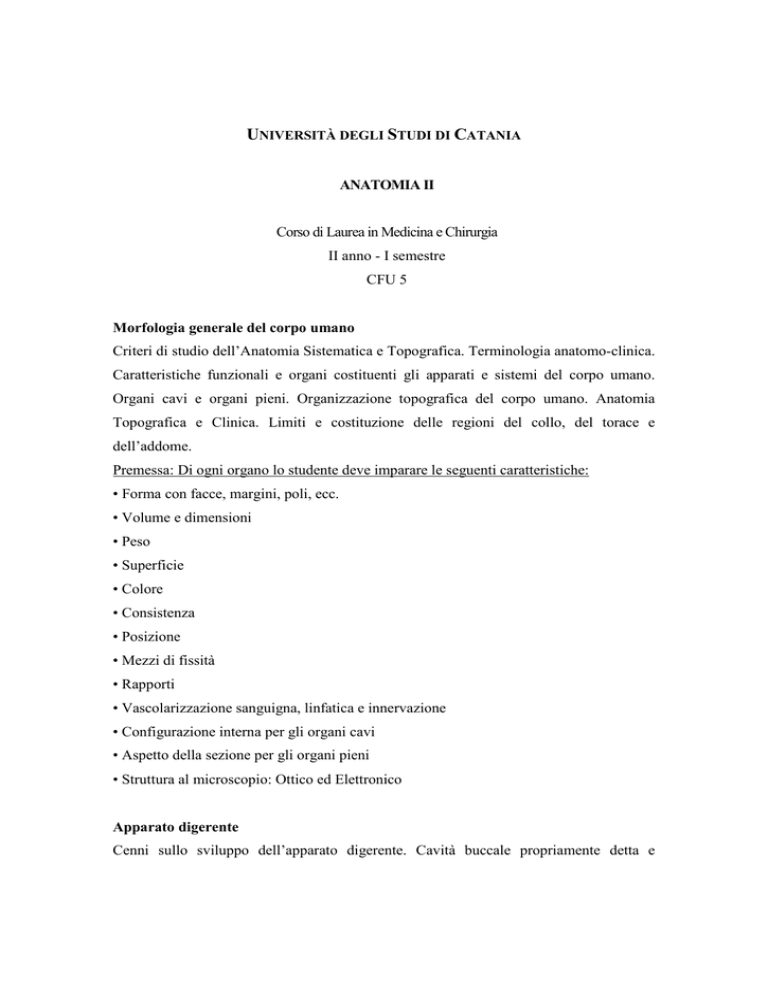
UNIVERSITÀ DEGLI STUDI DI CATANIA
ANATOMIA II
Corso di Laurea in Medicina e Chirurgia
II anno - I semestre
CFU 5
Morfologia generale del corpo umano
Criteri di studio dell’Anatomia Sistematica e Topografica. Terminologia anatomo-clinica.
Caratteristiche funzionali e organi costituenti gli apparati e sistemi del corpo umano.
Organi cavi e organi pieni. Organizzazione topografica del corpo umano. Anatomia
Topografica e Clinica. Limiti e costituzione delle regioni del collo, del torace e
dell’addome.
Premessa: Di ogni organo lo studente deve imparare le seguenti caratteristiche:
• Forma con facce, margini, poli, ecc.
• Volume e dimensioni
• Peso
• Superficie
• Colore
• Consistenza
• Posizione
• Mezzi di fissità
• Rapporti
• Vascolarizzazione sanguigna, linfatica e innervazione
• Configurazione interna per gli organi cavi
• Aspetto della sezione per gli organi pieni
• Struttura al microscopio: Ottico ed Elettronico
Apparato digerente
Cenni sullo sviluppo dell’apparato digerente. Cavità buccale propriamente detta e
vestibolo della bocca; denti permanenti e denti di latte, lingua, ghiandole salivari
maggiori (parotide, sottomandibolare e sottolinguale) e minori. Tonsille. Faringe,
esofago, stomaco, intestino tenue (duodeno e intestino mesenteriale), intestino crasso
(cieco, colon e retto); fegato e pancreas. Peritoneo e retrocavità degli epiploon.
Apparato respiratorio
Cenni sullo sviluppo dell’apparato respiratorio. Naso esterno e interno, laringe
(cartilagini, muscoli e ligamenti, conformazione interna), trachea, bronchi principali e
loro ramificazioni, polmoni. Pleure.
Apparato urinario
Cenni sullo sviluppo dell’apparto urinario. Reni, vie escretrici dell’urina (calici, pelvi,
uretere). Vescica, uretra maschile e femminile.
Apparato genitale maschile
Cenni sullo sviluppo dell’apparato genitale maschile. Testicoli, vie spermatiche (tubuli
retti, rete testis, epididimo, condotto deferente, vescichette seminali, dotti eiaculatori),
ghiandole genitali annesse all’uretra maschile (prostata, ghiandole bulbo - uretrali).
Generalità sullo scroto e sugli involucri del testicolo, generalità sul pene.
Apparato genitale femminile
Cenni sullo sviluppo dell’apparato genitale femminile. Ovaia, trombe uterine ed utero.
Generalità sulla vagina e sul pudendo femminile.
Perineo
Morfologia del perineo.
Sistema endocrino
Tiroide, paratiroidi, ghiandole surrenali, isole di Langerhans; componente endocrina delle
gonadi maschile e femminile.
Testi Consigliati:
Anatomia Umana G. Anastasi et al., Edi-Ermes, Milano (3 vol).
Atlante Virtual Campus G. Anastasi, Ediermes. (3 Vol).
Testut - Jacob (3 volumi) UTET
Atlante di Anatomia Umana Sobotta, R. Putz, R. Pabst – Elsevier Masson (3 vol.)
Atlante di Anatomia Umana Frank H. Netter – Masson (1 volume)
Atlante di Anatomia Umana, Prometheus, Edises.
General morphology of the human body
Study criteria and Topographic Anatomy Systematics. Terminology anatomo-clinica.
Functional characteristics and constituent bodies of the apparatus and systems of the
human body. Solid organs and hollow organs. Topographical organization of the human
body. Topographic anatomy. Limits and constitution of the regions of the neck, chest and
abdomen.
Premise: Of each organ, the student must learn the following features:
• Shape with faces, edges, poles, etc..
• Volume and dimensions
• Weight
• Surface
• Color
• Consistency
• Position
• Means of fixity
• Reports
• Vascularization blood, lymph and nerve supply
• Internal configuration for hollow organs
• Appearance of the section for the full organs
• Structure microscopy: Optical and Electronic
Digestive System
Work on the development of the digestive system. Buccal cavity proper and the vestibule
of the mouth; milk teeth and permanent teeth, tongue, major salivary glands (parotid,
submandibular and sublingual) and minor. Tonsils. Pharynx, esophagus, stomach, small
intestine (duodenum and intestine mesenteric), large intestine (cecum, colon and rectum);
liver and pancreas. Retrocavity of the peritoneum and omentum.
Respiratory system
Work on the development of the respiratory system. Internal and external nose, larynx
(cartilages, muscles and ligaments, internal layout), trachea, main bronchi and their
ramifications, lungs. Pleura.
Urinary
Work on the development dell'apparto urinary tract. Kidneys, urinary tract urine
(chalices, pelvis, ureter). Bladder, urethra male and female.
Male genital system
Work on the development of the male genitalia. Testes, sperm ducts (straight tubules, rete
testis, epididymis, vas deferens, seminal vesicles, ejaculatory ducts), male genital glands
adjoining the urethra (prostate, bulbo - urethral). General information on the scrotum and
on the wrappers of the testis, general information about the penis.
Female genital system
Work on the development of the female genitalia. Ovary, uterus and uterine horns.
General information on the vagina and on the pudendal female.
Perineum
Morphology of the perineum.
Endocrine System
Thyroid, parathyroid, adrenal glands, the islets of Langerhans; endocrine component of
the male and female gonads.


